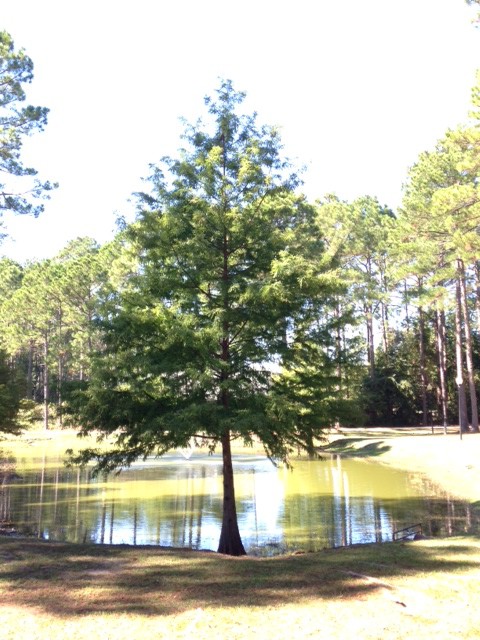
by Julie McConnell | Jun 2, 2015
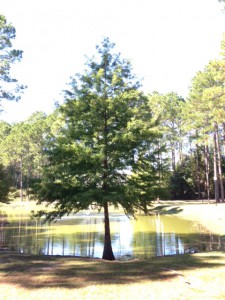
Bald cypress growing at the edge of a pond. Photo: Julie McConnell, UF/IFAS
Considering planting a tree in your landscape, but not sure what will do well?
Baldcypress, Taxodium distichum, is one tree you should consider for your Florida landscape. This deciduous conifer is native to North America and is suited to a wide variety of situations, even difficult ones!
Baldcypress is found naturally along stream banks and in swampy areas, but also performs well in dry situations once established. Not many trees can tolerate standing water or flooding situations, but baldcypress is well adapted to these tough spots. In areas that flood or remain wet the tree will form “knees” that project out of the ground and add a beautiful feature – just don’t plan to mow in areas where these develop. Not restricted to wet areas, baldcypress also performs well as a street tree or in limited root zone situations such as parking lot islands.
This tough tree has a soft, delicate leaf texture and interesting globular cones that start out green then turn brown as they mature. The foliage is light green through the spring and summer then turns a coppery gold before the needles fall in the winter. The trunk has a reddish color that is also attractive and will grow branches low to the ground, but can easily be maintained with a clear trunk in a street tree form.
Baldcypress will grow in full sun to part shade and is adapted to all soil types except highly alkaline (over 7.5 pH). Sand, loam, clay, or muck can all sustain this native tree. Few pests bother baldcypress, but it can be affected by bagworms and mites. Mature size can be in excess of 100 feet, but trees typically grow 60-80 feet tall in Florida.
For more information:
Taxodium distichum: Baldcypress
by Julie McConnell | Apr 13, 2015

New foliage of Japanese Plum Yew Photo credit: Julie McConnell, UF/IFAS
Trying to grow turfgrass in shaded areas is a losing battle but that doesn’t mean you have to settle for mulch in those dark areas of the landscape. There are many plants that will tolerate shady conditions found under the canopy of large trees, and some offer year round interest!
One of the most important aspects of site assessment is sun exposure. Plants need light, but do not all need the same amount or intensity.
If plants requiring full sun are planted in the shade, they tend to get leggy and do not flower well. Although they may live, they will not perform at their peak.
Shade loving plants grown in the sun may be stunted, show leaf scorch, and will struggle. Most shade plants can tolerate some filtered light or morning sun, but need to be protected from direct mid-day to afternoon sun.
So, what evergreen plants can add some color and texture to your shaded spots?
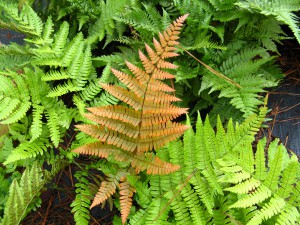
Golden tones of new foliage is what gives Autumn Fern its common name. Photo credit: Julie McConnell, UF/IFAS
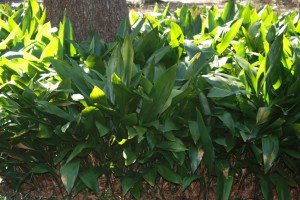
Cast Iron Plants under a live oak tree. Photo credit: Julie McConnell, UF/IFAS
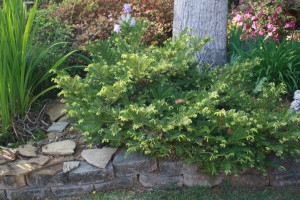
Japanese Plum Yew. Photo credit: Julie McConnell, UF/IFAS
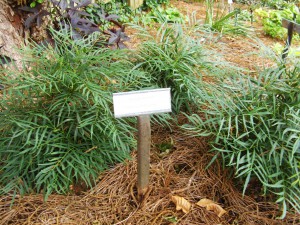
Soft Caress Mahonia. Photo Credit: Julie McConnell, UF/IFAS
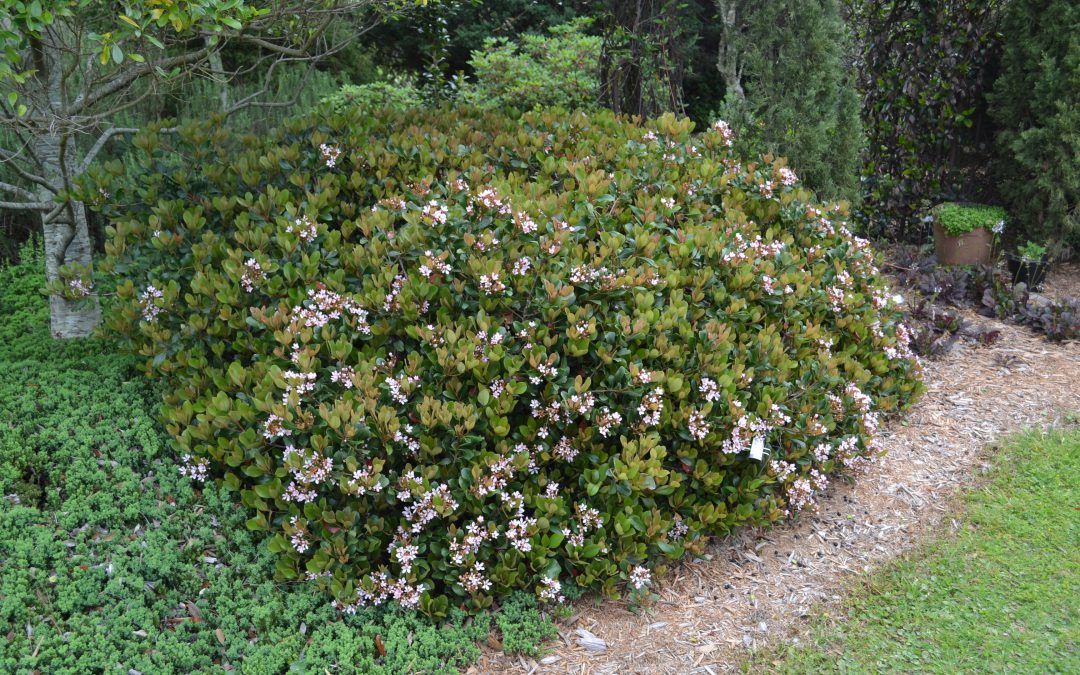
by Beth Bolles | Apr 7, 2015
One of the most commonly used shrubs in landscapes is the Indian hawthorn, Rhapheolepsis indica. Although not native to Florida, it can be a very attractive shrub when used properly in landscapes. Plants offer spring flowers in pinks and whites followed by berries that are a food source for birds.
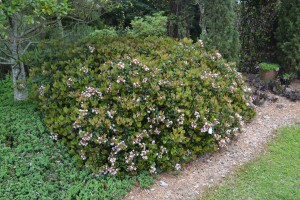
Indian hawthorn as a single planting can be attractive.
Indian hawthorn plants in landscapes are susceptible to a couple of pests that create unattractive and unhealthy plants. A leaf spot fungus called Entomosporium leaf spot easily spreads from infected plants through irrigation and rainfall leading to leaf discoloration, leaf drop, and dieback of limbs. Scale insects can also be common on leaves causing yellowing and dieback. The fungal problem is difficult to manage on heavily infected plants but the scale can be managed with a low toxicity pesticide choice such as a horticulture oil.
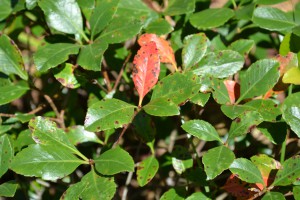
A heavy infection of leaf spot fungi is often too difficult to manage when plants are routinely irrigated.
Most often the problems on Indian hawthorn, especially fungal, are the result of poor management. This shrub likes sun, well-drained soil, and no overhead irrigation. Once established, plants should need little supplemental irrigation and water should only be applied to the base of plants. Since plants normally form a rounded mound, there is also little need for pruning if planted in a correct spot and spaced appropriately when planting. Most landscape installations of Indian hawthorn space plants based on the gallon pot size and not the mature size of the plant which is about 3-5 feet in height and spread.
Indian hawthorn can still be a good selection for homeowners. Buy healthy plants without any signs of spots on leaves and don’t plant a monoculture of these plants in the landscape. If one plant does have serious pest issue it is easier to either treat or remove one plant versus a mass planting.
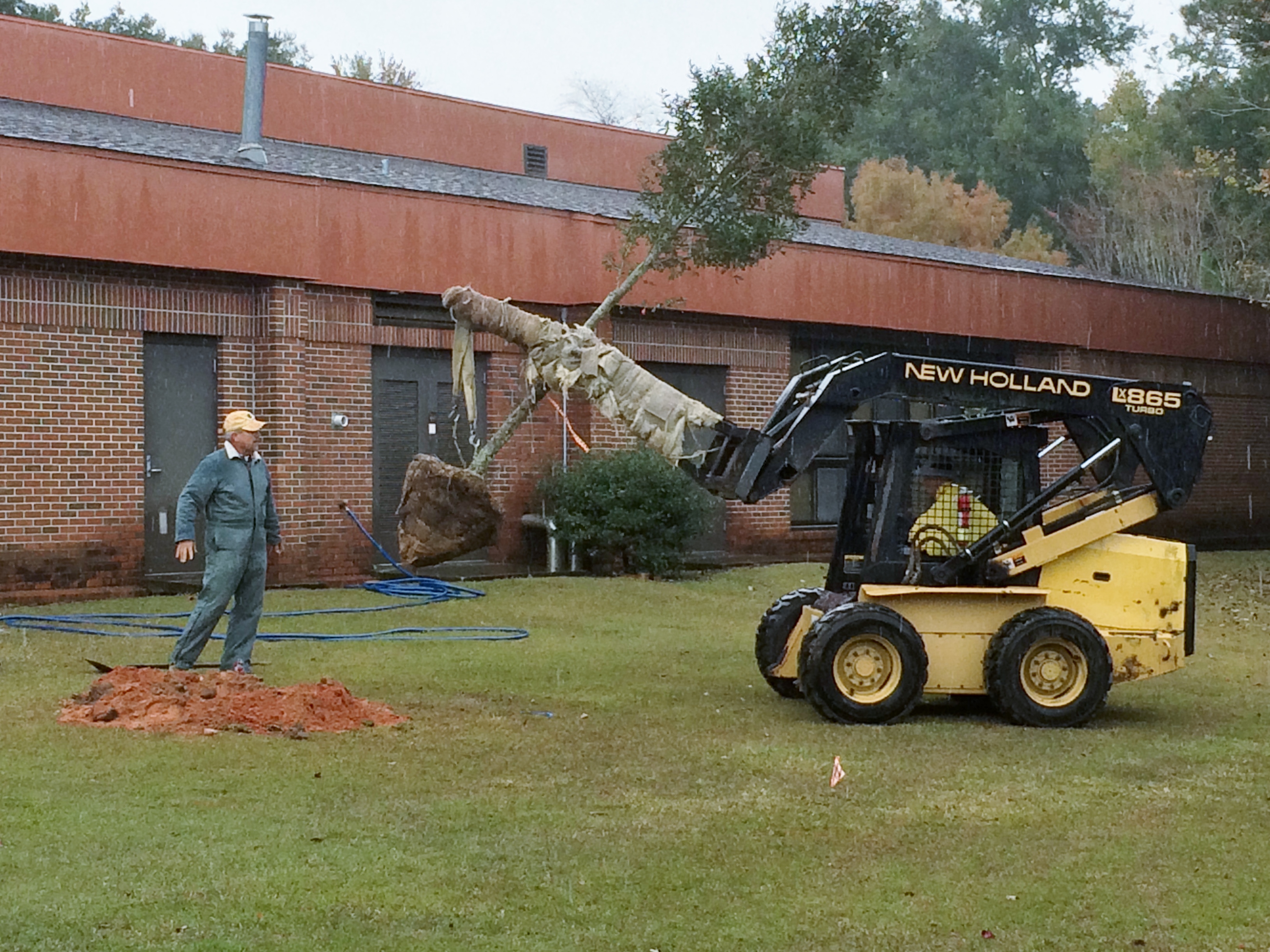
by Blake Thaxton | Nov 25, 2014
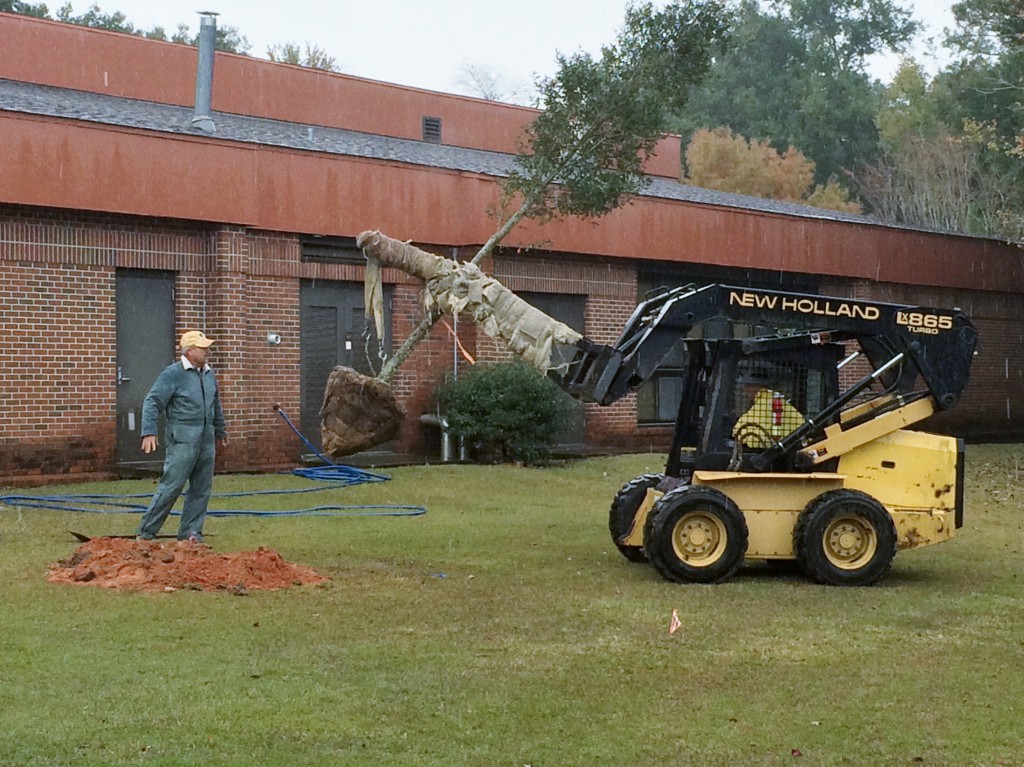
Photo Credit: Blake Thaxton
Often in Extension we are asked to look at unhealthy plants in the landscape. We see every problem under the sun. Whether it is diseases, insects, or cultural problems we run into them all. One problem that seems to be a trend, when clients show us a declining tree, is signs of improper tree installation. Though the tree may survive for 10 or 15 years after planting, it never thrives and it experiences a slow death. Here are 11 easy steps to follow for tree installation.
- Look Up
- Dig a shallow planting hole as wide as possible
- Find the point where the top-most root emerges from the trunk
- Slide the tree carefully into the planting hole
- Position the point where the top-most root emerges from the trunk slightly above the landscape soil surface
- Straighten the tree in the hole
- Remove synthetic materials from around trunk and root ball
- Slice a shovel down in to the backfill
- Cover the exposed sides of the root ball with mulch
- Stake the tree if necessary
- Come back to remove hardware
For more detailed information visit this UF/IFAS website.
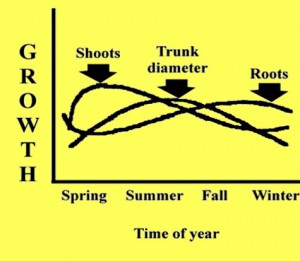
Also remember that fall is a great time to plant a tree because of the way trees grow. As you can see on the image above, roots tend to grow in the winter. This is a good thing so that the root system will be well established when spring comes and a new flush of growth will begin on the top of the tree.

by Julie McConnell | Oct 8, 2014
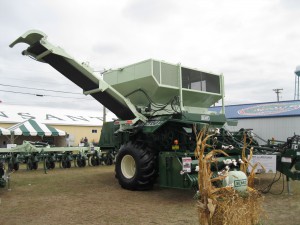 By Brad Buck, 352-294-3303, bradbuck@ufl.edu
By Brad Buck, 352-294-3303, bradbuck@ufl.edu
GAINESVILLE, Fla. – You can find out when to plant crops, how to can foods safely and how to use paper to pot plants from University of Florida experts at the 37th annual Sunbelt Ag Expo.
The Sunbelt Ag Expo, Oct .14-16 in Moultrie, Ga., is the largest agricultural expo in the southeast, and more than 100,000 people attend each year.
“The Sunbelt Expo gives people from all walks of life a chance to learn about everything Extension offers from our experts,” said Nick Place, dean of Extension for UF’s Institute of Food and Agricultural Sciences.
Known as North America’s Premier Farm Show and the largest such show in the U.S., the expo unites all segments of rural living. The setting features the latest agricultural research, a live farm harvest and insights into various agricultural businesses, according to its website.
UF/IFAS will have a permanent building, popular with visitors because of engaging displays and giveaways such as peanuts from the Florida Peanut Growers Association, Florida Orange Juice provided by Natalie’s Orchid Island Juice Company and many other “Gator Giveaways.”
This year, the Extension Service celebrates the centennial of the Smith-Lever Act of 1914, which created the national service, in which agents deliver unbiased research data to their constituents. Florida’s program remains as viable as ever, helping its many stakeholders. That includes guiding growers to maximize production through the most efficient use of their resources.
UF/IFAS’s three branches, Extension, research and the College of Agricultural and Life Sciences (CALS) will feature six interactive booths with the theme “Solutions for the Next 100 Years.”
Experts will interact with the public on several topics:
- “Canning parties” were some of the first Extension programs to help people better understand how to safely preserve foods. Expo visitors can learn more about this tradition as Family and Consumer Science Extension agents share from the past and present to provide the latest innovations for home food preservation.
- 4-H is one of UF/IFAS’ oldest recognized Extension programs. See how youth are leading and learning to meet the challenges of the next century. Visitors will learn about a 4-H recycling project and can take home a start to their family garden.
- Farming tools and methods are constantly improving. Visitors can see some of UF/IFAS’ favorites from the past and contrast them with flyin
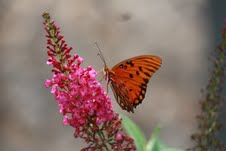 g drones and infrared scanners for today and the future. These new tools aid farmers in early identification of disease, pest and nutritional problems.
g drones and infrared scanners for today and the future. These new tools aid farmers in early identification of disease, pest and nutritional problems.
- Natural Resource and Sea Grant Extension agents are bringing Florida’s beaches and bays to Georgia. Touch tanks and displays with animals will highlight this exhibit focused on beach and boating safety and stewardship.
- Horticulture displays will give visitors insight into establishing a Florida Friendly yard by using appropriate plants and cultural methods. Butterfly gardening plants will be featured. Visitors will also learn how to distinguish beneficial insects from problem pests.
- Visit with CALS Ambassadors and learn about life as a UF agriculture student. Ambassadors will give information about major programs, admission, enrollment and hand out plenty of Gator goodies.

by Carrie Stevenson | Jan 14, 2014
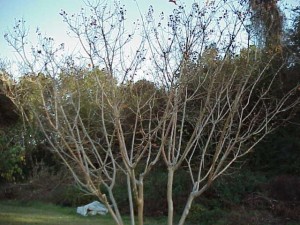
The branching structure of crape myrtles makes an impact to landscapes even in winter time. Photo credit: Beth Bolles
Most people associate yard work with the spring and summer, but if you’re considering a major redesign of a home landscape, now is a great time to start. Without the vegetation on deciduous trees, it’s easy to see the “bones” of your yard—the tree trunks and branches, sidewalks, and fences—which frame it.
One of the best ways to start with landscape design is a piece of paper and pencil. If you’ve got a paper copy of your survey, even better—you can sketch in trees, sidewalks, and fences with an aerial view and see where the open spots lie. Take some time to walk around your yard, considering how you use the space. Do you have children or pets that need room to run? A shady area for relaxing? Full sun for a garden? All of these uses can co-exist in a single yard, but the key to good landscape design is allowing for them to flow together in a logical, attractive way.
If you’ve never put together a comprehensive landscape design before, there are several very helpful tools online provided by horticulture experts with UF IFAS Extension. The “pattern guide” is ideal for starting and completing small projects, such as side yards, shade areas, etc. and even suggests appropriate plants based on light conditions and region of the state. Using this guide is a great way to start from scratch and build up to a diverse, healthy landscape. On the other hand, if you are essentially satisfied with your yard but just need a few accent plants or another tree somewhere, a great online resource is http://deactivated_site/. Here, you can enter a set of specific criteria based on the type of plants you’re looking for, and the site will create a customized list of suggestions to use in your landscape.

The online Florida-friendly landscaping pattern book has great ideas for redesigning your landscape.
After deciding on additional needs for hardscape and plantings, the next step is to make room for them by removing sod or unwanted landscape plants. Now is also the time to look at irrigation needs—if you have an existing system, make sure it still works with your new landscape design. If it doesn’t, it’s much better to redirect water, piping, or add new sprinkler heads while you’re digging into the soil than after you’ve finished installing new vegetation. If you aren’t using an irrigation contractor, you’ll need a solid understanding of how the system is set up before making changes. Inexpensive kits can also be purchased to add drip or micro-irrigation to an already-installed system.
Once irrigation and hardscape are complete, you can begin with plant installation. It makes the most sense to plant trees first, add mulch around the root zone, then put in shrubs and groundcovers based on your plan. Many do-it-yourselfers will take their time on this step, adding new plants as time and budget allow. This method works well and can be a fascinating way to watch your yard transform.
We have many great resources for more in-depth discussion of landscape design and irrigation work, including your local UF IFAS Extension office. Don’t hesitate to call us with questions or send photos of your new and improved yards!
















 g drones and infrared scanners for today and the future. These new tools aid farmers in early identification of disease, pest and nutritional problems.
g drones and infrared scanners for today and the future. These new tools aid farmers in early identification of disease, pest and nutritional problems.

